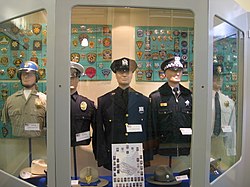 Police Museum, Glasgow | |
 | |
| Established | 2002 |
|---|---|
| Location | 30 Bell Street, Merchant Ciy, Glasgow |
| Coordinates | 55°51′29″N4°14′42″W / 55.8580°N 4.2449°W |
| Type | Law enforcement |
| Visitors | between 9000 and 10000 (2019) [1] |
| Director | Alastair Dinsmor |
| Website | https://www.policemuseum.org.uk/ |
The Glasgow Police Museum is an independent museum in the Scottish city of Glasgow. The museum opened in 2002 at the Glasgow Central Police Headquarters, before it was relocated to the Merchant City area of the city in 2009. [2] The museum is dedicated to the history of the City of Glasgow Police, the United Kingdom's first modern-style municipal police force. [3] It also displays a collection of over 2000 international police insignia and uniforms. [2]


